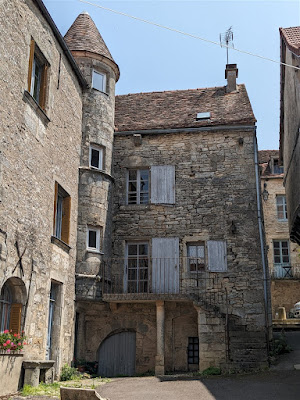Our next stop, now June 28th, was the village of Flavigny-sur-Ozerain, another of les plus beaux villages de France. The village is nice enough by itself, and very old, but it has a special attraction, the factory where the famous Anis de Flavigny candy is made, which will require a second post. But first, the town, starting with the remains of the Benedictine abbey there founded by Widerard in 719.
 |
| Helpful map |
 |
Extremely helpful chronology; click to enlarge and you
will read that Julius Caesar and his legions camped here--
bringing anise seeds for medicinal purposes--and gave
the place to one of his veterans, Flavinius, whose name
stuck |
 |
The Three Abbeys milestone...13th century, marking
the boundaries of the three abbeys, of which Flavigny's
was one...see below |
 |
| Rare dorsal view showing St. Seine and his famous donkey |
 |
Now entering the Carolingian (8th-9th cerntury) crypt of
the old Benedictine abbey; renovation was funded by the
Anis de Flavigny company (next post) |
 |
| Assorted remnants, helpfully labeled |
 |
Helpful design of the abbey church--now gone--with
the crypt to the left; not in English too, but--click to
enlarge--and the pix are pretty easy to follow |
 |
| Easy to tell which bits have been reconstructed |
 |
| Moving right along, seeing the town |
 |
Interestingly, the abbey church was destroyed in the
Revolution, but the parish church was untouched; only
five monks were left in the abbey by then, and the (secular;
i.e., corrupt) abbot; in the Revolution, the Second Estate
[the Church] was hated just as much as the First Estate
[the nobility] |
 |
| Some old paint remains |
 |
| Sic transit, Gloria...a setting for the film Chocolate; now for sale |
 |
| Stuff like this is part of the charm of these villages |
 |
One of the town portals...
|
 |
Alas, the walls and towers did not keep the English
out in the Hundred Years War |























































